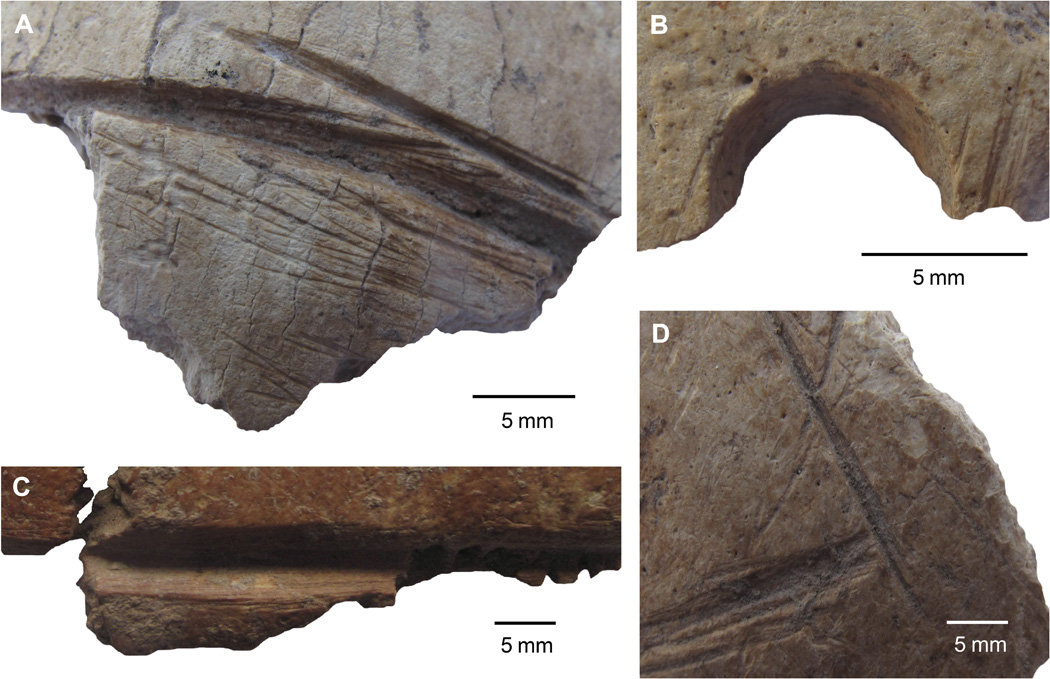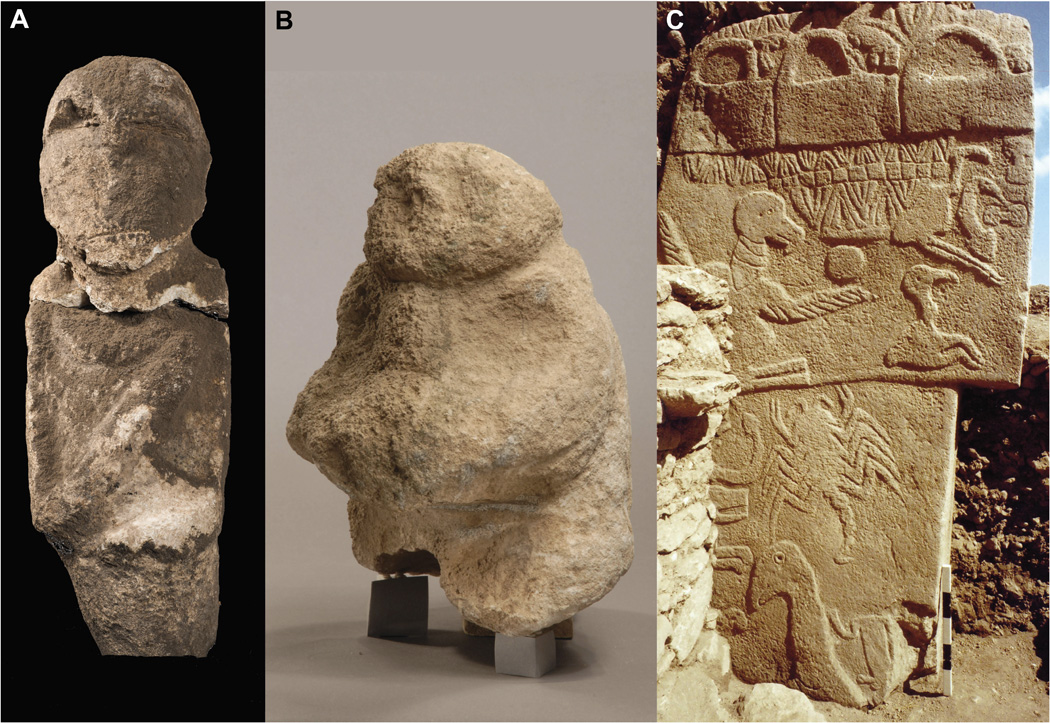It looks like you're using an Ad Blocker.
Please white-list or disable AboveTopSecret.com in your ad-blocking tool.
Thank you.
Some features of ATS will be disabled while you continue to use an ad-blocker.
19
share:

A) Skull 1: Fragment of frontal bone with carvings. (B) Fragment of left parietal bone with drilled perforation. (C) Skull 2: Fragment of right parietal bone with carvings. (D) Skull 3: Fragment of frontal bone with carvings. Credit: Julia Gresky, DAI.
Abstract
Archaeological excavations at Göbekli Tepe, a transitional Neolithic site in southeast Turkey, have revealed the earliest megalithic ritual architecture with characteristic T-shaped pillars. Although human burials are still absent from the site, a number of fragmented human bones have been recovered from fill deposits of buildings and from adjacent areas. We focus on three partially preserved human skulls, all of which carry artificial modifications of a type so far unknown from contemporaneous sites and the ethnographic record. As such, modified skull fragments from Göbekli Tepe could indicate a new, previously undocumented variation of skull cult in the Early Neolithic of Anatolia and the Levant.

A) Intentionally decapitated human statue (height, 60 cm). Credit: Nico Becker, Göbekli Tepe Archive, DAI. (B) The gift bearer holds a human head in his hands (height, 26 cm). Credit: Dieter Johannes, Göbekli Tepe Archive, DAI. (C) Pillar 43 (building D) with low relief of an ithyphallic headless individual, one arm raised (bottom right). Credit: Klaus Schmidt, Göbekli Tepe Archive, DAI.
The modifications observed on the three skulls from Göbekli Tepe present a previously undocumented treatment of human skeletons in the PPN (table S3). Furthermore, convincing parallels cannot be identified through comparison with other archaeologically and ethnographically documented skull treatments, including trepanation, production of utilitarian and art objects, and modifications in connection with fertility rituals and ancestor veneration (Table 1 and the Supplementary Materials). One explanation is that this particular variation of skull modification was connected with activities specific to the Göbekli Tepe site. For this reason, in the following discussion, the term skull cult is further elaborated (see also the Supplementary Materials), additional evidence for skull cult at Göbekli Tepe is presented, and the modifications found on the three skulls are compared to secondary treatments attested at other Neolithic sites.
advances.sciencemag.org...
At other Natufian sites the living also underwent some form of dental modification like tooth filing which had led earlier investigators to make them out to be cannibals of probable African origin from an old New York Times article.
BONES OF CANNIBALS A PALESTINE RIDDLE Wireless to THE NEW YORK TIMES.
New York Times 1857; Aug 4, 1932;
So who ever these folks were, they were probably not nice to look at, although ultimately responsible for a key stone in the step towards so called civilization.
edit on 3-7-2017 by Spider879 because: (no reason given)
a reply to: Spider879
S & F!
While this is fascinating, I'm not sold on the second set of pictures. They all seem like a stretch of this "headless" theme. Unless perhaps, the archeologists have further explanations.
How would they know statue A was intentionally decapitated?
Statue B can completely ambiguous.
And the relief in image C is pretty strange. Call me crazy, but I don't see a headless figure at all there.
S & F!
While this is fascinating, I'm not sold on the second set of pictures. They all seem like a stretch of this "headless" theme. Unless perhaps, the archeologists have further explanations.
How would they know statue A was intentionally decapitated?
Statue B can completely ambiguous.
And the relief in image C is pretty strange. Call me crazy, but I don't see a headless figure at all there.
originally posted by: AgarthaSeed
a reply to: Spider879
S & F!
While this is fascinating, I'm not sold on the second set of pictures. They all seem like a stretch of this "headless" theme. Unless perhaps, the archeologists have further explanations.
How would they know statue A was intentionally decapitated?
Statue B can completely ambiguous.
And the relief in image C is pretty strange. Call me crazy, but I don't see a headless figure at all there.
I can see like a break below the neck of statue A, off course it could be accidental , Statue B is worn down to be sure, but it does seem to be holding something.
I'm very keptical to these claims of a "cannibal death cult" of sorts. These new skulls are dated 2,000-3,000 years younger than the rest of the site,
we don't even know if these skulls were from the same culture that built the place. Also, it is only 3 skulls that has cut marks out of hundreds found
there. Great video from another skeptic on these new "skull cult" claims here.
-MM
-MM
edit on 3-7-2017 by MerkabaMeditation because: (no reason given)
a reply to: MerkabaMeditation
Like it or not, all of our ancestors were cannibals.
For some reason, it seems like it`s taboo in the world of archaeology.
Like it or not, all of our ancestors were cannibals.
For some reason, it seems like it`s taboo in the world of archaeology.
a reply to: Spider879
Those look like mechanical saw marks more than anything else..
And are they not dated to thousands of years after the site was buried?
How can you link the two? Skulls from 10,000 years ago to a site that was buried 11,600 years ago?
I dont see the connection. Sounds retarded.
It would be like finding a jeep wrangler buried in the dirt and saying the aztecs had cars. You're atleast 1,600 years off.
But they know most people are very stupid so eat it up if you like haha.
Those look like mechanical saw marks more than anything else..
And are they not dated to thousands of years after the site was buried?
How can you link the two? Skulls from 10,000 years ago to a site that was buried 11,600 years ago?
I dont see the connection. Sounds retarded.
It would be like finding a jeep wrangler buried in the dirt and saying the aztecs had cars. You're atleast 1,600 years off.
But they know most people are very stupid so eat it up if you like haha.
edit on 3-7-2017 by Reverbs because: (no reason
given)
edit on 3-7-2017 by Reverbs because: (no reason given)
a reply to: MerkabaMeditation
It strikes me that there is and has been
Archaeology began as a science with the firm believe that everything on earth that shows signs of manipulation was done by early humans. Some of which were know, suspected or completely unknown until a particular rock was turned over. Basically, archaeology generally matches the way science has dealt with (or not) the evidence for UFOs and their ETIs. That position is "NO, IT CANNOT BE!"
We lowly commoners look at those encompassing interpretations of archaeologist (and related experts) and naturally question their findings. Shall we add that basing these findings on other elusive findings is a fairly shaky platform from which to project? I'm reminded of Sagan's shaky and constant pronouncement (paraphrased) that "Yes, ETIs are out there in deep space, but they can't get here."
Much of this whole business of humankind's history is being intentional kept below the awareness of the average person today because of a fear of the dynamite effect the whole truth would have on the world's populace. It is all tied together, the origins of our species, the origins of our sciences and edifices, and the modern return of the ETIs for our next great challenge. So the only defense they have is to postulate all sorts of explanations away from any and all evidence of the truth.
It strikes me that there is and has been
Archaeology began as a science with the firm believe that everything on earth that shows signs of manipulation was done by early humans. Some of which were know, suspected or completely unknown until a particular rock was turned over. Basically, archaeology generally matches the way science has dealt with (or not) the evidence for UFOs and their ETIs. That position is "NO, IT CANNOT BE!"
We lowly commoners look at those encompassing interpretations of archaeologist (and related experts) and naturally question their findings. Shall we add that basing these findings on other elusive findings is a fairly shaky platform from which to project? I'm reminded of Sagan's shaky and constant pronouncement (paraphrased) that "Yes, ETIs are out there in deep space, but they can't get here."
Much of this whole business of humankind's history is being intentional kept below the awareness of the average person today because of a fear of the dynamite effect the whole truth would have on the world's populace. It is all tied together, the origins of our species, the origins of our sciences and edifices, and the modern return of the ETIs for our next great challenge. So the only defense they have is to postulate all sorts of explanations away from any and all evidence of the truth.
a reply to: Skywatcher2011
It was common practice to drill holes in ones head, if you were insane, or you had too much pressure in the brains, from a head injury.
It was common practice to drill holes in ones head, if you were insane, or you had too much pressure in the brains, from a head injury.
Yeah, not buying the idea of a 'skull cult.'
It seems that archaeology gets rather lazy when they cannot come up with a definitive answer and always revert to religious/cult reasons for the existence of things in ancient cultures.
It seems that archaeology gets rather lazy when they cannot come up with a definitive answer and always revert to religious/cult reasons for the existence of things in ancient cultures.
new topics
-
What Comes After January 20th
Mainstream News: 36 minutes ago -
Canada as a state .. how would it work?
General Chit Chat: 45 minutes ago -
Those stupid GRAVITE commercials
Rant: 1 hours ago -
Let's Buy Greenland
General Chit Chat: 2 hours ago -
Planned Civil War In Britain May Be Triggered Soon
Social Issues and Civil Unrest: 5 hours ago -
Claim: General Mark Milley Approved Heat and Sound Directed Energy Weapons During 2020 Riots
Whistle Blowers and Leaked Documents: 6 hours ago
top topics
-
Claim: General Mark Milley Approved Heat and Sound Directed Energy Weapons During 2020 Riots
Whistle Blowers and Leaked Documents: 6 hours ago, 11 flags -
Planned Civil War In Britain May Be Triggered Soon
Social Issues and Civil Unrest: 5 hours ago, 5 flags -
Let's Buy Greenland
General Chit Chat: 2 hours ago, 4 flags -
What Comes After January 20th
Mainstream News: 36 minutes ago, 4 flags -
Those stupid GRAVITE commercials
Rant: 1 hours ago, 2 flags -
Canada as a state .. how would it work?
General Chit Chat: 45 minutes ago, 0 flags
active topics
-
What Comes After January 20th
Mainstream News • 4 • : JadedGhost -
Let's Buy Greenland
General Chit Chat • 11 • : CarlLaFong -
Those stupid GRAVITE commercials
Rant • 3 • : Cre8chaos79 -
Canada as a state .. how would it work?
General Chit Chat • 5 • : CriticalStinker -
Gravitic Propulsion--What IF the US and China Really Have it?
General Conspiracies • 30 • : Lazy88 -
Remember These Attacks When President Trump 2.0 Retribution-Justice Commences.
2024 Elections • 133 • : Oldcarpy2 -
Sorry to disappoint you but...
US Political Madness • 40 • : cherokeetroy -
January 6th report shows disturbing trend (nobody is shocked)
US Political Madness • 72 • : JadedGhost -
-@TH3WH17ERABB17- -Q- ---TIME TO SHOW THE WORLD--- -Part- --44--
Dissecting Disinformation • 3954 • : Thoughtful3 -
Claim: General Mark Milley Approved Heat and Sound Directed Energy Weapons During 2020 Riots
Whistle Blowers and Leaked Documents • 20 • : NoCorruptionAllowed
19
